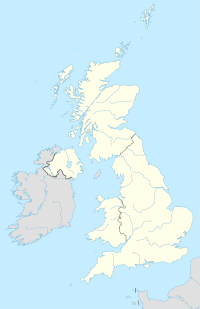
Edward II, also called Edward of Caernarfon, was King of England from 1307 until he was deposed in January 1327. The fourth son of Edward I, Edward became the heir to the throne following the death of his older brother Alphonso. Beginning in 1300, Edward accompanied his father on campaigns to pacify Scotland, and in 1306 he was knighted in a grand ceremony at Westminster Abbey. Edward succeeded to the throne next year, following his father's death. In 1308, he married Isabella of France, the daughter of the powerful King Philip IV, as part of a long-running effort to resolve the tensions between the English and French crowns.

Edward III, also known as Edward of Windsor before his accession, was King of England from January 1327 until his death in 1377. He is noted for his military success and for restoring royal authority after the disastrous and unorthodox reign of his father, Edward II. Edward III transformed the Kingdom of England into one of the most formidable military powers in Europe. His fifty-year reign was one of the longest in English history, and saw vital developments in legislation and government, in particular the evolution of the English Parliament, as well as the ravages of the Black Death. He outlived his eldest son, Edward the Black Prince, and was succeeded by his grandson Richard II.

Piers Gaveston, 1st Earl of Cornwall was an English nobleman of Gascon origin, and the favourite of Edward II of England.
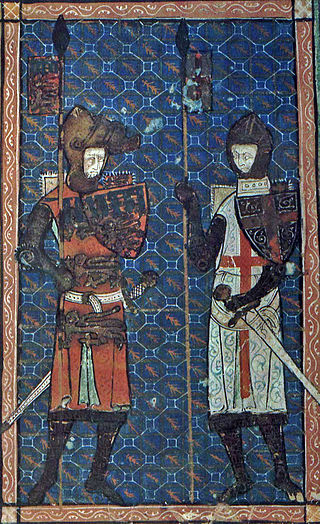
Thomas, 2nd Earl of Lancaster was an English nobleman of the first House of Lancaster of the royal Plantagenet Dynasty. He was Earl of Lancaster, Leicester, and Derby from 1296 to 1322, and Earl of Lincoln and Salisbury jure uxoris from 1311 to 1322. As one of the most powerful barons of England, Thomas was one of the leaders of the baronial opposition to his first cousin, King Edward II.
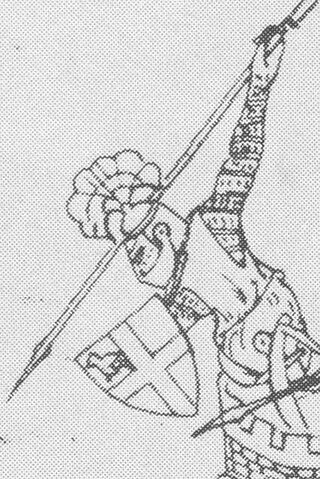
Andrew Harclay, 1st Earl of Carlisle, alternatively Andreas de Harcla, was an important English military leader in the borderlands with Scotland during the reign of Edward II. Coming from a knightly family in Westmorland, he was appointed sheriff of Cumberland in 1311. He distinguished himself in the Scottish Wars, and in 1315 repulsed a siege on Carlisle Castle by Robert the Bruce. Shortly after this, he was taken captive by the Scots, and only released after a substantial ransom had been paid. His greatest achievement came in 1322, when he defeated the rebellious baron Thomas of Lancaster at the Battle of Boroughbridge on 16–17 March. For this he was created Earl of Carlisle.

Edmund Fitzalan, 2nd Earl of Arundel was an English nobleman prominent in the conflict between King Edward II and his barons. His father, Richard Fitzalan, 1st Earl of Arundel, died in 1302, while Edmund was still a minor. He, therefore, became a ward of John de Warenne, Earl of Surrey, and married Warenne's granddaughter, Alice. In 1306 he was styled Earl of Arundel, and served under Edward I in the Scottish Wars, for which he was richly rewarded.

Guy de Beauchamp, 10th Earl of Warwick was an English magnate, and one of the principal opponents of King Edward II and his favourite, Piers Gaveston. Guy was the son of William de Beauchamp, the first Beauchamp earl of Warwick, and succeeded his father in 1298. He distinguished himself at the Battle of Falkirk and subsequently, as a capable servant of the crown under King Edward I. After the succession of Edward II in 1307, however, he soon fell out with the new king and the king's favourite, Piers Gaveston. Warwick was one of the main architects behind the Ordinances of 1311, that limited the powers of the king and banished Gaveston into exile.
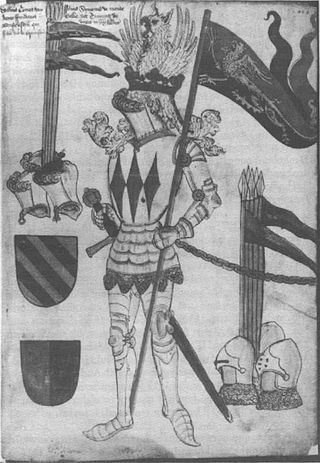
William Montagu, alias de Montacute, 1st Earl of Salisbury, 3rd Baron Montagu, King of Man was an English nobleman and loyal servant of King Edward III.

Aymer de Valence, 2nd Earl of Pembroke was an Anglo-French nobleman. Though primarily active in England, he also had strong connections with the French royal house. One of the wealthiest and most powerful men of his age, he was a central player in the conflicts between Edward II of England and his nobility, particularly Thomas, 2nd Earl of Lancaster. Pembroke was one of the Lords Ordainers appointed to restrict the power of Edward II and his favourite Piers Gaveston. His position changed with the great insult he suffered when Gaveston, as a prisoner in his custody whom he had sworn to protect, was removed and beheaded at the instigation of Lancaster. This led Pembroke into close and lifelong cooperation with the king. Later in life, however, political circumstances combined with financial difficulties would cause him problems, driving him away from the centre of power.

The title of Earl of Lancaster was created in the Peerage of England in 1267. It was succeeded by the title Duke of Lancaster in 1351, which expired in 1361.

Edmund of Woodstock, 1st Earl of Kent, whose seat was Arundel Castle in Sussex, was the sixth son of King Edward I of England, and the second by his second wife Margaret of France, and was a younger half-brother of King Edward II. Edward I had intended to make substantial grants of land to Edmund, but when the king died in 1307, Edward II refused to respect his father's intentions, mainly due to his favouritism towards Piers Gaveston. Edmund remained loyal to his brother, and in 1321 he was created Earl of Kent. He played an important part in Edward's administration as diplomat and military commander and in 1321–22 helped suppress a rebellion.
Gilbert de Clare, 8th Earl of Gloucester, 7th Earl of Hertford was an English nobleman and military commander in the Scottish Wars. In contrast to most English earls at the time, his main focus lay in the pursuit of war rather than in domestic political strife. He was the son of Gilbert de Clare, 7th Earl of Gloucester, and Joan of Acre, daughter of King Edward I. The older Gilbert died when his son was only four years old, and the younger Gilbert was invested with his earldoms at the young age of sixteen. Almost immediately, he became involved in the defence of the northern border, but later he was drawn into the struggles between Edward II and some of his barons. He was one of the Lords Ordainers who ordered the expulsion of the king's favourite Piers Gaveston in 1311. When Gaveston was killed on his return in 1312, Gloucester helped negotiate a settlement between the perpetrators and the king.

John of Brittany, 4th Earl of Richmond, was an English nobleman and a member of the Ducal house of Brittany, the House of Dreux. He entered royal service in England under his uncle Edward I, and also served Edward II. On 15 October 1306 he received his father's title of Earl of Richmond. He was named Guardian of Scotland in the midst of England's conflicts with Scotland and in 1311 Lord Ordainer during the baronial rebellion against Edward II.
Events from the 1320s in England.
The Ordinances of 1311 were a series of regulations imposed upon King Edward II by the peerage and clergy of the Kingdom of England to restrict the power of the English monarch. The twenty-one signatories of the Ordinances are referred to as the Lords Ordainers, or simply the Ordainers. English setbacks in the Scottish war, combined with perceived extortionate royal fiscal policies, set the background for the writing of the Ordinances in which the administrative prerogatives of the king were largely appropriated by a baronial council. The Ordinances reflect the Provisions of Oxford and the Provisions of Westminster from the late 1250s, but unlike the Provisions, the Ordinances featured a new concern with fiscal reform, specifically redirecting revenues from the king's household to the exchequer.
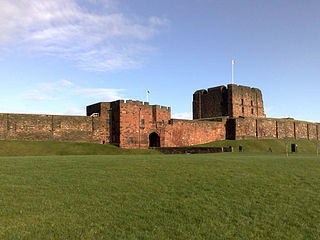
The siege of Carlisle took place from 22 July to 1 August 1315, during the First War of Scottish Independence, near the town of Carlisle, in Cumbria, England.

The Boulogne agreement was a document signed by a group of English magnates in 1308, concerning the government of Edward II. After the death of Edward I in 1307, discontent soon developed against the new king. This was partly due to lingering problems from the previous reign, but also related to issues with Edward II himself. Particularly his abandonment of the Scottish Wars and his patronage of the unpopular Piers Gaveston caused discontent. Drawn up in Boulogne-sur-Mer during the king's nuptials, the document vaguely asserted the signatories' duty to guard the rights of the Crown. Three months later, the agreement was the basis for another document, justifying opposition to the king. This latter document, the so-called Declaration of 1308, is notable for its use of the "doctrine of capacities": the distinction between the person of the King and the institution of the Crown.

The 1322 Battle of Burton Bridge was fought between Thomas, 2nd Earl of Lancaster and his cousin King Edward II of England during the Despenser War. Edward's army was proceeding northwards to engage Lancaster, having defeated his Marcher Lord allies in Wales. Lancaster fortified the bridge at Burton upon Trent, an important crossing of the River Trent, in an attempt to prevent the King from proceeding. Edward arrived at nearby Cauldwell on 7 March 1322 and intended to use the ford at Walton-on-Trent to cross the river and outflank Lancaster. Edward was delayed for three days by floodwaters, during which time some of his force was deployed opposite Lancaster's men at the bridge.
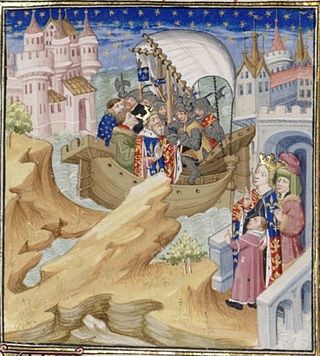
The Parliament of 1327, which sat at the Palace of Westminster between 7 January and 9 March 1327, was instrumental in the transfer of the English Crown from King Edward II to his son, Edward III. Edward II had become increasingly unpopular with the English nobility due to the excessive influence of unpopular court favourites, the patronage he accorded them, and his perceived ill-treatment of the nobility. By 1325, even his wife, Queen Isabella, despised him. Towards the end of the year, she took the young Edward to her native France, where she entered into an alliance with the powerful and wealthy nobleman Roger Mortimer, who her husband previously had exiled. The following year, they invaded England to depose Edward II. Almost immediately, the King's resistance was beset by betrayal, and he eventually abandoned London and fled west, probably to raise an army in Wales or Ireland. He was soon captured and imprisoned.

